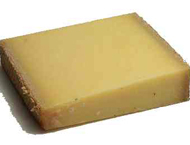
The name of the Gruyere cheese appears as Gruiere in 1655, which comes from the Gruyere, the district in the canton of Fribourg, where it was made.
Val de Charmey, a region with high mountain pastures, has been the place of the fabrication and affinage of Gruyere and Vacherins cheeses since the mists of time, and goes back to the presence of the Celts, the Helvetii, and the Romans. There is not enough known to say that these setters knew how to make cheese. The legend goes that the emperor Antonin-le-Pieux dies from indigestion from a cheese made in Gruyere, in the year 161 AD.
From the Middle-Ages, the pastures were used by the people of the region who reared their herds of cows. They paid their land rent in cheese and serac. Guilliame, the first count of Gruyere, founded, with his nephew the canon of Ulrich, the Cluniac church of Rougemont. The charter established in 1115 assured him different benefits, among others was the cheese made in the mountains of Gruyere. The monastary had to deliver the materials; boilers, sieves, moulds…. The chalets on the High mountain pasture collected the milk from the herds in Gruyere, but only in the period when there was vegetation. In Fribourg, the selling of cheese began in 1249. In October 1312, the sons of Rodolphe de Gruyere liberated those living in Gessenay from the charter of 1115. They established a document related to the fabrication of a ‘fatty cheese’ in the mountain chalets of this region made for exportation, which permitted people to make money from the selling of the cheese. On the 21st February 1342, the price of butter and cheese was fixed. Guyere was then sold at the markets of Vevey and Geneva.
The cheese travelled further, to the markets of Lyon, Paris and Italy. Until the end of the 15th Century, the area where the cheese was made was dominated by the counts of Gruyere, who were noble land owners. Documents and news about the cheese was rare for a century. At the beginning of the 30 Year War (1618-1648) the exportation of Gruyere developed, and the state of Fribourg took the first measures to protect the cheese. In 1740, the market sellers proposed to the notables of Fribourg that the good quality Gruyere should be distinguishable from the other cheeses by marking it with a letter ‘G.’
At this time, the level of production of the Gruyere is estimated to have been between 2,500 and 3,000 tonnes. In 1762, the ‘Acadamy Français’ added the word ‘Gruyere’ to the dictionary, specifying that it was a sort of cheese made in Gruyere. From 1764, the sellers/exporters of the Gruyere were given the permission by the government of Fribourg to mark their cheeses with a stamp of the crane (the bird, emblem of the house of Gruyere). The 18th and 19th Centuries were more turbulent. Drawn by higher salaries, the personnel of the canton of Fribourg moved to, such as Vaud, Neuchâtel, Savoie, Franche-comté and the Jura. This led to Gruyere being imitated and renamed, as the personnel took with them the practices of fabrication of Gruyere. In 1856, at the agricultural show in Paris, two exhibitors from Fribourg obtained gold medals for their Gruyere cheeses.
The success of the cheese made more people want to buy it. In the 1860s and the years that followed, Gruyere was enjoyed by the Indians of the British colony and the Dutch.
A treaty was signed between the French and the Swiss in 1864 with the aim to find ways to export the cheese further afield. At the end of the 1860s, in Fribourg there were 254 places where the cheese was produced. A ‘Manual of cheese’ was published by R. Schatzmann in 1873. From 1890, the government of Fribourg imposed a reform of the status of the society of milk producers
Without any protection of its origin or quality, Gruyere was prone to imitations, and so the battle to protect its identity started in April 1891.
The 1926 international congress of the dairy industry, in Paris, adopted the following resolution; “The names of cheeses that derive from their place of origin, like Emmental, Gruyere, Parmesan, Roquefort, Camembert can be applied to distinguish only their origin.”
The 10 June 1930, in Rome, the ‘international convention for the protection of the designation and unification of the methods of analysis.’
This strategic decision was defeated by the dairy profession in France, in Besançon on the 14th February 1931. The 19th June 1931, Emile Savoy, state counsellor of Fribourg, developed an interjection of the Convention of Rome to protect the Gruyere. He wanted for there to be a distinction in the quality of the cheeses. In 1935, Bernard de Gottrau launched a passionate crusade for Gruyere cheese, declaring that the French argument that Gruyere was of French origin, was unbearable.
On the 2nd July 1992, the Charter of Gruyere was created, limiting the area of production to the cantons of Fribourg, Vaud, Neufchatel and Jura, as well as the districts of Courtelary, Neuveville and Moutier in the canton of Berne. The ‘interprofession of Gruyere’ was created in 1997 which co-ordinated the production and sale of Gruyere. This ‘interprofession’ groups the milk producers, the cheese makers and the affineurs, to assure the quality, identity and promotion of Gruyere. The history of Gruyere shows that it has merited its reputation for centuries. Today, it is the quality of the Gruyere which is protected.